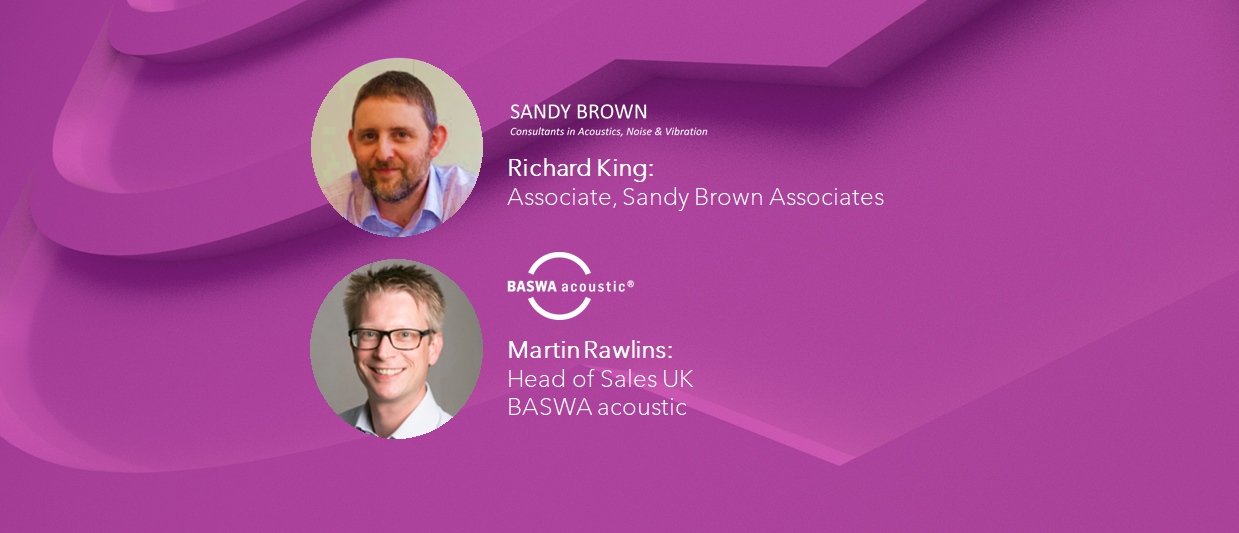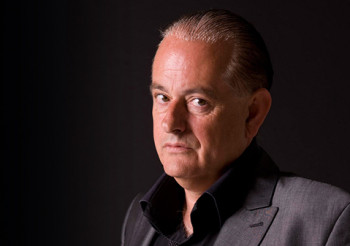Freedom Day Special - Acoustics in Large Public Spaces


FREEDOM DAY SPECIAL - Acoustics in Large Public Spaces
With Richard King - Associate at Sandy Brown and Martin Rawlins - Head of Sales UK at BASWA acoustic
Have you dusted off your dancing shoes, and visited a nightclub yet? Or how about a cinema, or a museum? Freedom Day (it was branded in the UK) has come, and gone, COVID restrictions have been lifted all but entirely and at the time of writing it’s not really clear whether positive cases are going up or down. Nobody is quite sure.
One thing which is for sure is that the way we perceive ‘open’ public spaces has changed, and our considerations now more than ever take into account the cleanliness and wellbeing factors, one of which is the acoustic quality of an environment.

From Sandy Brown Associates, the largest independent acoustic consultancy in the UK, we have Richard King, and alongside him is Martin Rawlins from BASWA acoustic. BASWA are creators of BASWA Phon (which can be found on our Acoustic Academy), the most advanced and most specified acoustic plaster system worldwide. Both have years of experience providing acoustic expertise in offices, cultural institutions, auditoria and performance spaces.
Richard starts by quipping that his job once placed 2nd on a BBC article of the top 10 ‘most unusual job titles’. In fact the range of work acoustic consultants perform alongside developers and architects is very diverse. They’ll ensure that you’re not annoyed by hearing the local supermarket’s air-con on its roof, through to the insulation in houses and flats so you don’t hear neighbours, to those more specialist fit-outs like recording studios, theatres and concert halls.
One of those large open spaces, an exhibition hall for the V&A ‘Cars’ exhibit, required some of that specialist thinking. As a temporary space that was large and open, how did they overcome the usual challenges to keep sound separate?
“We effectively turned a wall inside out. We had a temporary structure with a solid core in the middle, with sound absorption on the outside… this contained the sound within certain zones so that different sections didn’t interfere with one another.”

From innovative walls which absorb sound, Martin introduces us to his company’s ceilings — which amongst having have their own innovative properties — can also be found nestled in that same building, in the new members area of the V&A.
“It’s a beautiful space with coffered ceilings. BASWA was used to provide that magic function of sound absorption. It’s so useful to be able to integrate sound absorption into interior architecture. It increases speech intelligibility … it prevents reflections… which creates the cacophony and cavernous sound — which can even happen in meeting rooms, restaurants, all sorts of environments.”
Their new products have greater impact resistance as well, passing ‘the basketball test’, which if we need to explain is, withstanding the impact of a basketball thrown at the surface.

Image: The V&A Museum Members' Room, London
Luckily for Richard and his colleagues, he doesn’t need to keep a up-to-date encyclopaedic knowledge of every kind of plaster or other treatment for doors, floors and windows — instead, computer aided design software has greatly improved the speccing process, to improve the calculability of the desired end result — to control ‘reverberation time’.
“When we have a more complicated space, we create a 3D model, inside a ‘ray-tracing’ package. We assign an absorption coefficient, which is how much sound a surface absorbs. The model then fires out rays in all directions and knows how much energy each should lose, and [calculating it again] in turn the reflected ray, which now has less energy…"
And while it might not be quite as simple as drag and dropping new materials into the software, they can effectively cycle through options of materials to see which meet their desired criteria, to find the right absorptive surface.
Martin apologises that BASWA alone ship 90 performance options, but by making these options for use inside the software, it vastly helps give practices like Sandy Brown confidence about the expected performance of the spaces, before they ever set foot to install anything.
One special project Sandy Brown were tasked with was to refit the grade II listed BAFTA Piccadilly cinema auditorium. Richard explains how a suspended ceiling on spring hangers could isolate the sound, preventing noise-polluting the foyer and rest of the building (and vice-versa).
“We built the 3D model, put all the surface finishes in and looked at the reverberation times across the whole space, checking we weren’t over-absorbing in any frequencies”.
 Image: BAFTA Piccadilly cinema auditorium
Image: BAFTA Piccadilly cinema auditorium
Using this software earlier in the design process requires a bit of a shift in thinking by architects, but when compared to the alternative, of acoustic consultants being brought in and involved at the tail end of the job—“there are opportunities to add value, rather than retro-fitting somewhat last-minute, and therefore simply adding cost.”
In offices, it can be tricky, Richard continues, as some building tenants decide to remove ceilings for aesthetic purposes, but sacrifice function along the way. Extroverted workers may enjoy open-plan office spaces, but Richard thinks it’s important staff can control their environment, have private conversations, or perform “focus working” uninterrupted with somewhere like a law firm.
“It’s not one size fits all… to get the best productivity out of staff… our job is to ensure a good experience for the people that work there.”
For any budding acousticians, Richard’s musical background began as a chorist, then playing guitar, and has made him acutely aware of his audible surroundings. His physics degree led him to pursue a part-time diploma in acoustics from the Institute of Acoustics — and he advises architects or engineers to consider masters degree routes too. “There’s even now an apprenticeship scheme for technicians which is being rolled out… you’d need some additional study to become a consultant, as it has an engineering focus… having that analytical, critical approach to a problem really helps.”

Image: BAFTA Headquarters, London
BASWA are showing off their engineering prowess with one new product that can integrate heating and radiant cooling too. Martin gleefully explains that, of course, being radiant means it’s completely quiet — so is perfect for a space where even a rumbling whirr of an air-conditioning unit would be out of place.
Lockdown and the rise of video conferencing has also offered them a chance to educate on panelling they can install even in smaller spaces, as any and everywhere becomes commandeered for taking more of these calls. “As more and more rooms will be used for these purposes, you really need to put treatment on the walls”.
Martin appeared at the Grand Designs ‘Ask an Expert’ show, but was keen to stress that for some people, just making their first exploratory inquiries for residential properties, there was a much misunderstood difference between sound ‘proofing’ and the broader topic of interior room acoustics and sound absorption.
“People don’t realise that—even in the architectural and design community itself—many aren’t aware that these are separate and you can use materials that absorb sound and will make a huge difference. People may walk into a noisy room and think that’s just the way it is.
“We rely on an educated client, and educated architect, beforehand, to realise the materials they’re using and then thinking ‘there may well be a problem with the acoustics here!’”
Richard agrees, and decries that some companies will simply try and sell products “such as foam… and that is not going to change the sound insulation of your room!”
In forums and comments sections online, Richard has witnessed first-hand others mis-diagnosing each others noise problems. “People may try to add additional cavities in walls to deal with noise of neighbours… actually what can happen is the sound insulation goes down because the resonances coincide… It gets a little frustrating when companies are selling sound proofing when it’s not. And when others advise putting up some egg-boxes and ultimately… that won’t help.
So if you are struggling with a noise problem, the good news is there is almost certainly a solution out there, and an acoustic consultant will know how to deal with them. Of course, the earlier you can involve an expert, ideally before the problem exists, you’ll be one step closer to sonic nirvana. Plus with materials like BASWA Phon you can rest assured you and your architects designs can also be realised to perfection.
Read more about BASWA Phon in our Acoustics Academy

Listen to Richard & Martin discuss more about ‘Acoustics in Large Public Spaces’ on The Quiet Mark Podcast








 Quiet Mark Founder
Quiet Mark Founder